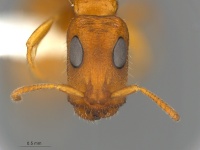Tetraponera ambigua species group
This article is based on Ward, P. S. 2006. The ant genus Tetraponera in the Afrotropical region: synopsis of species groups and revision of the T. ambigua-group (Hymenoptera: Formicidae). Myrmecologische Nachrichten 8:119-130.
Worker diagnosis
- Small to medium-sized species (HW 0.51 - 0.91)
- Masticatory margin of mandible with four (in one species six) teeth
- Basal margin lacking distinct teeth (small denticle may be present near apicobasal tooth) and shorter than masticatory margin
- Labrum without prominent teeth or tubercles
- Anteromedial margin of clypeus crenulate or entire
- Distance between frontal carinae notably exceeding basal scape width (FCI 0.15 - 0.25)
- Scape length one half to two thirds of head width (SI 0.52 - 0.65)
- Compound eyes directed anteromedially
- Head capsule without ocelli or with a lateral pair only (if present usually weakly developed), median ocellus lacking
- Pronotum with soft lateral margination
- Mesonotum either extending to propodeum or separated from it by a weakly differentiated area (metanotum or mesoscutellum)
- Posteroventral margin of petiole well separated from helcium venter
- Metabasitarsal sulcus generally absent (present in one species)
- Upper half of mesosternum sparsely pubescent
- Appressed pubescence dense on abdominal tergite 4
- Worker caste dimorphic, with a discrete soldier (major worker) subcaste
Workers of the T. ambigua-group can be distinguished by the orientation of their compound eyes: the long axis is directed anteromedially towards the midline of the front of the head. In all other Tetraponera species the eyes are directed anteriorly or anterolaterally. The group is also unique among pseudomyrmecines in having a discrete subcaste of major workers. Small size (minor worker HW < 0.95) separates workers of the T. ambigua group from those of all other species groups except the T. allaborans-group
Identification
Key to Tetraponera ambigua group species
Distribution
Africa, Arabian Peninsula, Madagascar
Species
- Tetraponera ambigua (Emery, 1895)
- Tetraponera ophthalmica (Emery, 1912)
- Tetraponera parops Ward, 2006
- Tetraponera phragmotica Ward, 2006
Related pages
- Tetraponera
- Key to Afrotropical Tetraponera species groups
- Tetraponera species groups - List of species groups, links to individual species group webpages, and more.


